PART 3
Purchasing a Tea Cup
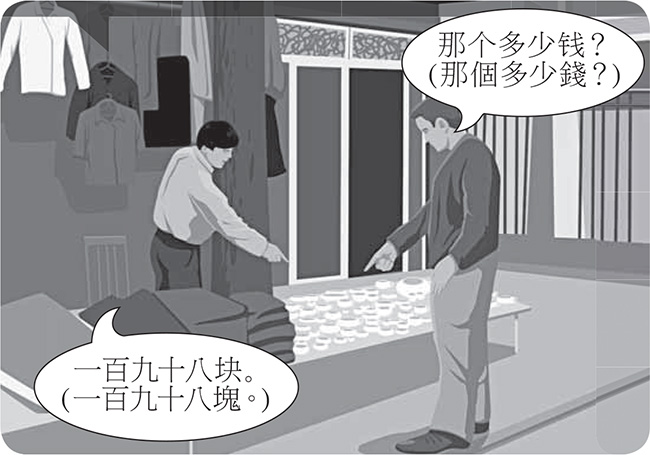
New Characters and Words 
Study the six characters below and the common words written with them, paying careful attention to each character’s pronunciation, meaning, and structure, as well as similar-looking characters. After you’ve studied a character, turn to the Practice Book volume and practice writing it on the practice sheet, making sure to follow the correct stroke order and direction as you pronounce it out loud and think of its meaning.
109 |
那 |
nà/nèi- |
that |
Radical is 邑 yì “city” [BF], which is written 阝 when occurring at the right-hand side of a character. This radical is referred to colloquially as 右耳旁 yòu’ĕrpáng “side made up of a right ear.” The other component of 那 is said to have meant “fur.” Originally, 那 was the name of a “city” in the west of Sichuan whose inhabitants wore “furs.” The character was later used to represent the sound of the word for “that,” which had no character of its own. 那 itself can serve as a phonetic in a few characters, e.g., in 哪 nĕi-/nă- (73) and in 娜 Nà (female personal name). Contrast 那 with 明 míng (15) and 哪 nĕi-/nă- (73). While the characters 那 and 哪 are now usually distinguished, be aware that in older texts and even now in the writing of some Chinese, 那 may represent either 那 or 哪. Therefore, if a sentence or phrase seems puzzling and it doesn’t make sense to interpret 那 as “that,” examine the punctuation and context and consider the possibility that 那 is being used in place of 哪 to mean “which?” or a related question word. |
|||
那 |
nà/nèi- |
that [PR/SP]; in that case, so [CJ] |
|
那个 (那個) |
nèige |
that one, that |
|
那位 |
nèiwèi |
that (person; polite) |
|
110 |
少 |
shăo |
few |
Radical is 小 xiăo “small,” which gives an idea of the meaning “few.” However, distinguish carefully between 少 and 小 “small” (24). The whole character 少 can serve as a phonetic, e.g., in 沙 shā “sand,” 纱 (紗) shā “gauze,” 吵 chăo “noisy,” 炒 chăo “stir-fry.” Contrast 少 with 小 xiăo (24). |
|||
多少 |
duōshăo |
how much, how many [QW] |
|
111 |
钱(錢) |
qián |
money |
Radical is 金 jīn “gold, metal” [BF] since money, in the form of coins, is often made from metal. The radical 金 jīn is referred to colloquially as 金字旁 jīnzìpáng “side made up of the character 金.” When used as a radical in writing simplified characters, the sixth and seventh strokes of 金 are deleted, so that the radical is simplified to 钅. When writing traditional characters, the last stroke of 金 as a left-side radical slants up toward the right, so as not to get in the way of the other component(s). The phonetic in 钱 (錢) is 戋 (戔) jiān “small” [BF], which occurs as a phonetic in many characters and represents the sound jian, qian, or zhan (in various tones). |
|||
钱 (錢) |
qián |
money [N] |
|
钱 (錢) |
Qián |
Qian (also Jeon, Cheon, or Chon, a common Korean surname) [SN] |
|
多少钱 (多少錢) |
duōshăo qián |
how much money? |
|
112 |
块(塊) |
kuài |
piece, lump, dollar |
Radical is 土 tŭ “earth.” The colloquial name for this radical is 土字旁 tŭzìpáng “side made up of the character 土.” Notice that the top horizontal line of 土 is shorter than the bottom line. Also, notice that when used as a radical, the bottom line of 土 slants up toward the right, so as not to get in the way of the other component. Phonetic of the simplified form is 夬 kuài, a rare character meaning “fork.” Phonetic of the traditional form is 鬼 guĭ “devil.” 块 (塊) has acquired the meaning “dollar” because before there was a standardized currency, people used “pieces” of gold or silver to barter for goods just as “dollars” are used today. |
|||
块 (塊) |
kuài |
dollar (monetary unit) [M] |
|
两块钱 (兩塊錢) |
liăngkuài qián |
two dollars |
|
113 |
百 |
-băi |
hundred |
Radical is 白 bái “white,” which in this character also serves as the phonetic. |
|||
百 |
-băi |
hundred [N] |
|
一百 |
yìbăi |
one hundred |
|
两百块钱 (兩百塊錢) |
liăngbăikuài qián |
two hundred dollars |
|
114 |
千 |
-qiān |
thousand |
Radical is 十 shí (11). 千 itself can serve as a phonetic in some characters, e.g., in 迁 ( 遷 ) qiān “move” and in 纤 ( 纖 ) xiān as in 纤维 ( 纖維 ) xiānwéi “fiber.” Contrast 千 with 十 shí (11). |
|||
千 |
-qiān |
thousand [NU] |
|
一千 |
yìqiān |
one thousand |
|
五千块钱 (五千塊錢) |
wŭqiānkuài qián |
five thousand dollars |
|
New Words in BMC–SL 3-3 Written with Characters You Already Know 
吧 |
ba |
(indicates suggestions) [P] |
贵 (貴) |
guì |
be expensive [SV] |
○ |
líng |
zero [NU] |
Reading Exercises (Simplified Characters) 
Now practice reading the new characters and words for this lesson in context in sentences, conversations, and narratives. Be sure to refer to the Notes at the end of this lesson, and make use of the accompanying audio disc to hear and practice correct pronunciation, phrasing, and intonation.
A. LARGER NUMBERS AND SUMS OF MONEY
Read out loud each of the following larger numbers and money expressions, making sure to think carefully of the meaning of what you’re reading.
1. 三百二十一
2. 五百七十七
3. 两千
4. 九百九十八
5. 六千七百二十一
6. 九千九百九十九
7. 四千三百三十
8. 两百七十七
9. 四千两百二十
10. 六千七百五十五
11. 六百块钱
12. 五百五十五块
13. 九千块
14. 三块五
15. 五千六百八十八块钱
16. 两千三百块钱
17. 一百〇一
18. 一千〇一
19. 两千〇五十个
20. 八百〇八块钱
B. SENTENCES
Read out loud each of the following sentences, which include all the new characters of this lesson. The first time you read a sentence, focus special attention on the characters and words that are new to you, reminding yourself of their pronunciation and meaning. The second time, aim to comprehend the overall meaning of the sentence.
一、这位男老师姓高,那位女老师姓钱。
二、五十块钱?太贵了!那,这个多少钱?
三、中国多少人姓王?美国多少人姓 Smith?
四、先生,两个人去中国,两千块钱,太贵了!
五、我们的公司很大,七百人。你的公司多少人?
六、九十九岁的那位中国老太太姓安,对不对?
七、她不是香港人?那,她是台湾人吧?
八、他叫李南,今年四岁了,你们叫他“南南”吧。
九、谢太太,今年去不好,您今年别去了!
十、小王,那个两千五百块钱,太贵了。
C. CONVERSATIONS
Read out loud the following conversations, including the name or role of the person speaking. If possible, find a partner or partners and each of you play a role. Then switch roles, so you get practice reading all of the lines.
一、
美国人:那个多少钱?
中国人:哪个?
美国人:那个。
中国人:是这个吗?
美国人:不是这个,是那个!
二、
美国人:小姐,请问,这个多少钱?
香港人:这个⋯⋯一百九十九块。
美国人:太贵了。那个呢?那个多少钱?
香港人:那个二十三块五。
三、
那先生:请问,这个多少钱?
钱小姐:这个⋯⋯两千块。
那先生:两千块太贵了吧!
钱小姐:那,一千九百块,好不好?
D. CHARACTER DIFFERENTIATION DRILLS
Distinguish carefully the following similar-looking characters, pronouncing each one out loud and thinking of its meaning.
一、那 那 那 哪 哪 哪
二、那 哪 哪 那 那 哪 那
三、少 少 少 小 小 小
四、少 小 少 少 小 小 少
五、千 千 千 十 十 十
六、千 十 千 千 十 十 千
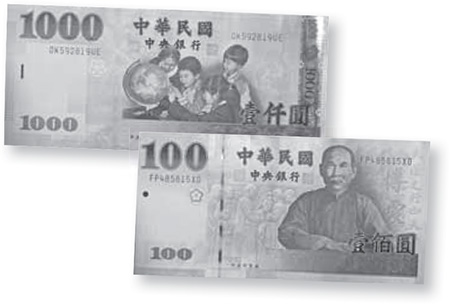
Taiwan currency
E. NARRATIVE
Read the following narrative, paying special attention to punctuation and overall structure. The first time you read the narrative, read it out loud; the second time, read silently and try to gradually increase your reading speed. Always think of the meaning of what you’re reading.
你问我去北京一个人多少钱?好,去北京一个人一百二十块。去香山多少钱?去香山两百八十块。去天津呢?去天津四百五十块。去上海呢?去上海一个人一千四百块。去美国一个人多少钱?这个你别问我;请你问那个人吧!
Reading Exercises (Traditional Characters) 
A. LARGER NUMBERS AND SUMS OF MONEY
Read out loud each of the following larger numbers and money expressions, making sure to think carefully of the meaning of what you’re reading.
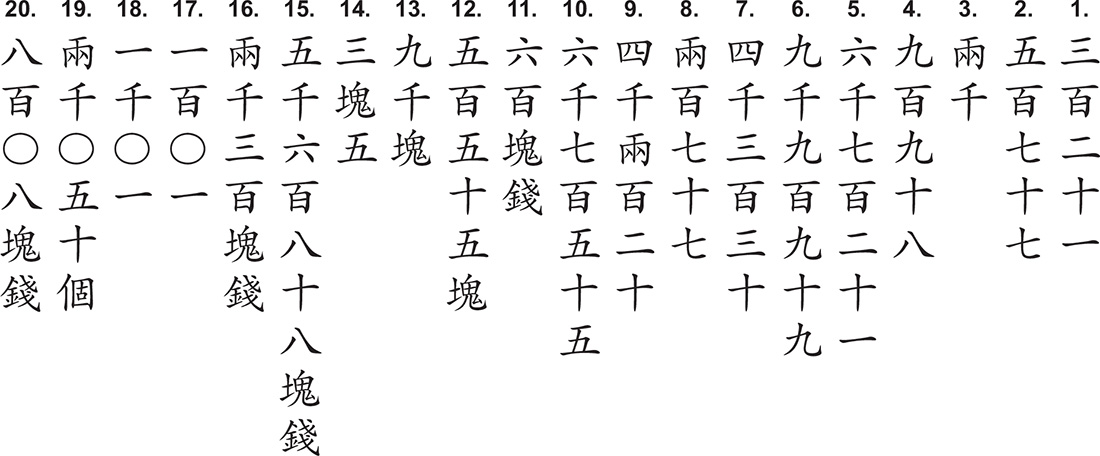
B. SENTENCES
Read out loud each of the following sentences, which include all the new characters of this lesson. The first time you read a sentence, focus special attention on the characters and words that are new to you, reminding yourself of their pronunciation and meaning. The second time, aim to comprehend the overall meaning of the sentence.

C. CONVERSATIONS
Read out loud the following conversations, including the name or role of the person speaking. If possible, find a partner or partners and each of you play a role. Then switch roles, so you get practice reading all of the lines.
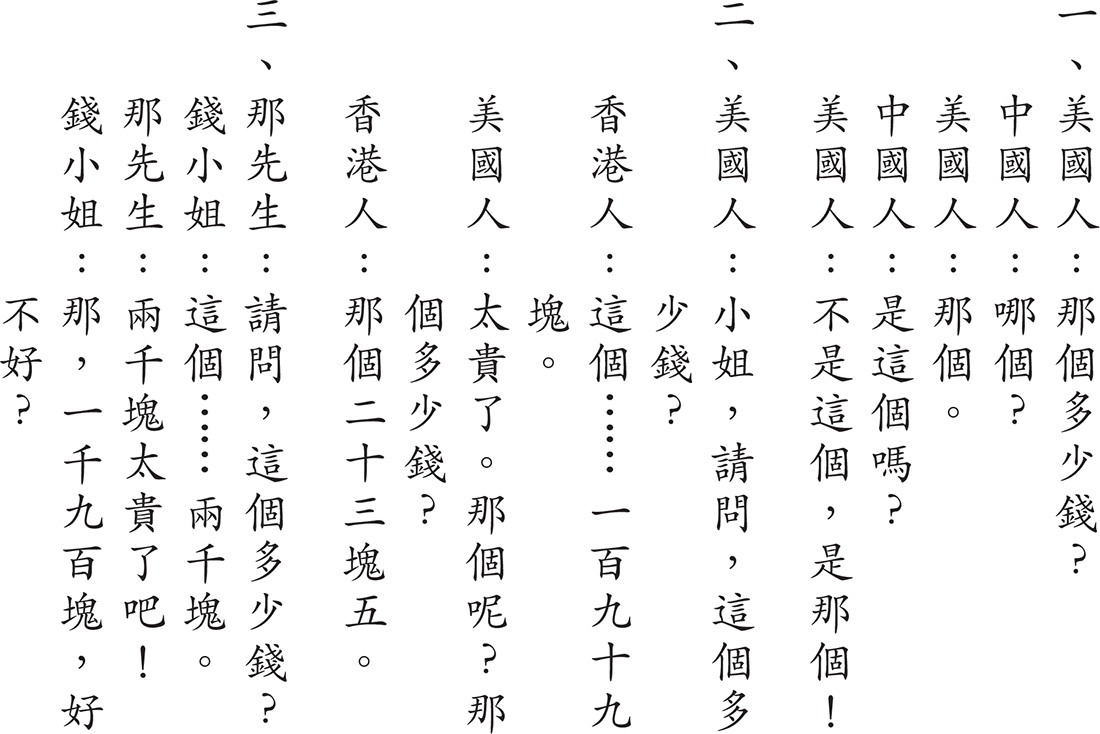
D. CHARACTER DIFFERENTIATION DRILLS
Distinguish carefully the following similar-looking characters, pronouncing each one out loud and thinking of its meaning.
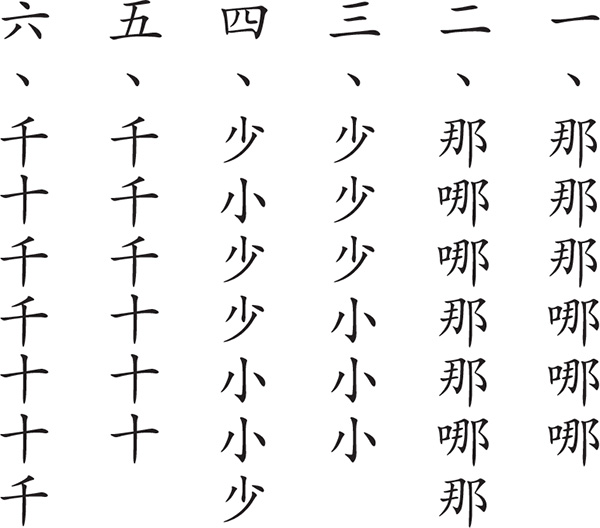
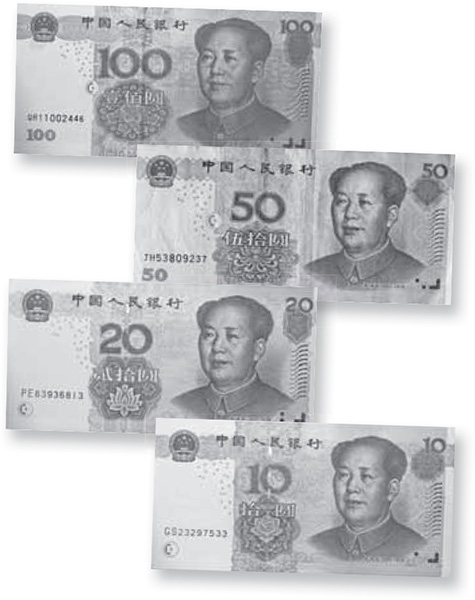

Chinese currency
E. NARRATIVE
Read the following narrative, paying special attention to punctuation and overall structure. The first time you read the narrative, read it out loud; the second time, read silently and try to gradually increase your reading speed. Always think of the meaning of what you’re reading.

Notes
A17-20. The Chinese number 〇 líng “zero” is written rounder than in English; it would not be considered correct to write it with the Arabic numeral 0. Líng can also be written with the Chinese character 零, but nowadays 〇 is even more common, especially when writing years, room numbers, telephone numbers, and page numbers.
A20. LONG FORMS OF THE NUMBERS. (The following is for reference only; you don’t need to learn this information now.) Since the Chinese characters 一二三四五六七八九十 are quite simple, consisting of only a few strokes, the potential exists for dishonest people to try to alter them, for example, to add two strokes and create a 三 out of a 一, or to add one stroke and create a 十 out of a 一. Therefore, to prevent alteration or confusion and to make the numbers appear more “official,” on financial records and on currency, the numbers are often written in more complex “long forms.” If you open a bank account in mainland China, Taiwan, or Hong Kong, you will need to write these long forms of the numbers on withdrawal slips and other official forms. The long forms have the same pronunciations as the ordinary forms. The long forms of the numbers from 1 to 10, plus 100 and 1,000, are as follows:
ORDINARY FORM |
LONG FORM |
ORDINARY FORM |
LONG FORM |
|
一 |
壹 |
七 |
柒 |
|
二 |
贰 (貳) |
八 |
捌 (捌) |
|
三 |
叁 |
九 |
玖 |
|
四 |
肆 |
十 |
拾 |
|
五 |
伍 |
百 |
佰 |
|
六 |
陆 ( 陸 ) |
千 |
仟 |
B2. 五十块钱?( 五十塊錢?) “Fifty dollars?” is an Intonation Question (cf. BMC–SL 2-3: 1c).
B4. 两个人去中国,两千块钱,太贵了!( 兩個人去中國,兩千塊錢,太貴了!) “$2,000 for two people to go to China is too expensive!”
B5. 七百人 means the same as 七百个人 (七百個人). In writing and sometimes in speaking, measures can be omitted between 百 or 千 and 人.
E. 你问我去北京一个人多少钱?(你問我去北京一個人多少錢?) “You’re asking me how much it costs for one person to go to Beijing?” This sentence involves the Question Word Question 去北京一个人多少钱?(去北京一個人多少錢?) being embedded within the Intonation Question 你问我?(你問我?).